For More Information
The Second Language Proficiency Test (TPLS) is an educational resource created by the Collegial Centre for Educational Materials Development (CCDMD) for the Québec college network.
The CCDMD’s mandate is to ensure that students throughout the network have access to quality educational materials in both French and English, and to contribute to the development of such materials at the different stages of production. The CCDMD produces materials for students in a wide range of courses and programs as well as documents intended specially to help them improve their French and English language skills.
These services are funded by the Québec Ministère de l'Éducation et de l'Enseignement supérieur (MEES) and, in some cases, benefit from support under the Canada-Québec Agreement on Minority-language Education and Second Language Instruction.
Colleges wishing to use this test must have a subscription. Anyone wishing to use it for commercial purposes must enter into a specific agreement with the CCDMD. To become a subscriber or to obtain more information, please contact the CCDMD by email at tpls@ccdmd.qc.ca or by telephone at (514 873-2200).
Background
In the fall of 2012, the Collegial Centre for Educational Materials Development (CCDMD) was entrusted with a new mandate to develop a second language proficiency test. The CCDMD set up a production team (project managers, content specialists, programmers and technicians) after having consulted some twenty professionals and experts in the college and university networks. When the technical analysis was concluded, the CCDMD proposed an adaptive test model and a linguistic scale based on new criteria.
Educational Objectives
The primary objective of the Second Language Proficiency Test (TPLS) is to determine the proficiency level of the respondent in order to propose appropriate courses as well as tailored learning activities within those courses.
At the end of the test, the result is given as a number from 1 to 10 corresponding to a level on the linguistic scale.

The teacher and student can then consult the proficiency level descriptions for information on what the student is able to do at that level. The teacher can also use this information to plan learning activities to help the student progress to the next level. As a result, the TPLS goes further than a traditional placement test, such as the eTCALS, which is designed strictly to assign a student to a course level according to his or her results. Note, however, that a test manager in a subscribing college has the option in the management module to associate a course number with each of the 10 levels.
The proficiency of students taking an upgrading (mise à niveau) course is at the lower levels of the scale. A level 10 result means that the student may be more proficient than the maximum level measured by the test. Ideally, college graduates should reach level 8: subsequent university training should enable students to fine-tune their proficiency and achieve level 9 or higher during their university studies.
Features
The TPLS is made up of two categories of items: written comprehension and oral comprehension. There are five types of items: associations, multiple choice, sequencing, cloze text with drag and drop, and cloze text with menus. Each item includes:
- general instructions, provided in words and images;
- a text (written comprehension) or audio recording (oral comprehension);
- a question;
- a choice of answers.
The TPLS is an adaptive test, which is non-linear: each correct or incorrect answer affects the progression of the test. The test gradually estimates the provisional skill level of the respondent (θ value) and dynamically selects the next item most likely to assess the respondent’s actual skill level. The test continues until the estimated skill level becomes stable, and the final θ value is translated into a proficiency level on the language scale that is the reference for the measurement system.
An adaptive test, in comparison with a non-adaptive test, makes it possible to reduce the number of items presented and decrease the test administration time, which can increase the reliability of skill assessment.
Sample Item Types
There are five item types:
- Associations
Drag and drop the answer choices to form pairs. - Multiple choice
Select the correct answer from a list of possible answers. - Sequencing
Drag and drop the answer choices in the correct order to form a logical text. - Cloze text with drag-and-drop
Drag and drop the correct answers into the blank spaces. - Cloze text with menus
Select the correct answer from a list of possible answers.
The answers to the following questions can be found in this text:

ASSOCIATIONS: Drag and drop the answer choices to form pairs.
Respond to an association question by pairing each of a set of elements in the 2nd column with one of the choices provided in the 1st column. Association questions are used to assess recognition and recall of related information. The response is deemed correct when the respondent has successfully matched all of the elements.
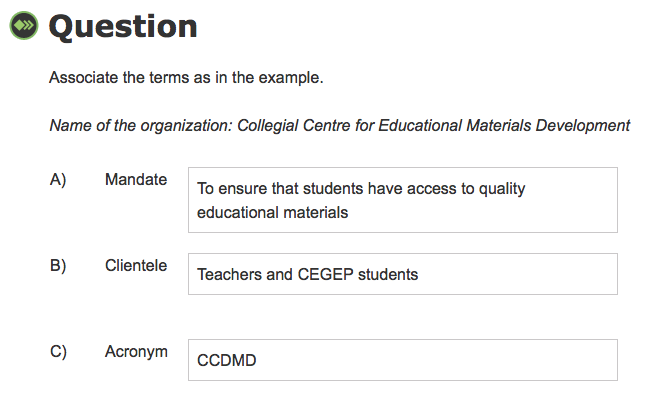
MULTIPLE CHOICE: Select the correct answer from a list of possible answers.
Respond to a multiple choice question by selecting the correct answer from a list that includes the correct answer and several incorrect answers. Multiple choice questions are used to test comprehension of a broad range of content. The context of the item and the type of response required determines whether the item is recall or interpretation. The response is deemed correct when the respondent has selected the single correct answer.
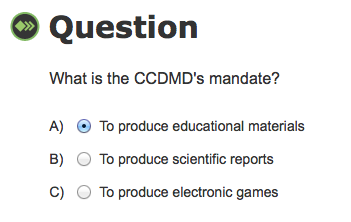
SEQUENCING: Drag and drop the answer choices in the correct order to form a logical text.
Respond to a sequencing question by dragging the elements into the correct order. Sequencing questions are used to test the ability to recall a series of events or a process in the order in which it was presented. They measure the ability to construct meaning and comprehend logical consequences expressed in verbal or written form. The response is deemed correct when the respondent has arranged all of the elements in the correct order.
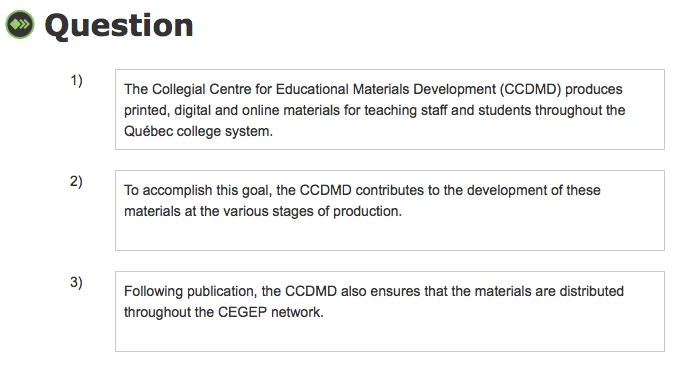
CLOZE TEXT: Drag and drop the correct answers into the blank spaces.
Respond to a cloze text with drag-and-drop question by filling in the blanks in a text. Drag the correct answer from a predefined set of possible answers above the text to the appropriate blank in the text. Cloze text with drag-and-drop questions are used to assess language skills by imitating the editing process. They measure the ability to infer the most appropriate conclusion to an incomplete statement. The response is deemed correct when the respondent has filled in all of the blanks correctly.
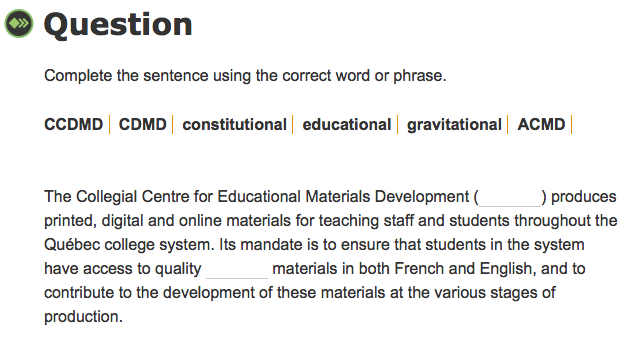
CLOZE TEXT: Select the correct answer from a list of possible answers.
Respond to a cloze text with menus question by filling in the blanks in a text. Select the correct answer from a predefined list of possible answers. Cloze text with menus questions are used to assess the ability to compare options and make accurate choices. Cloze text with menus questions are simpler to decode than cloze text with drag-and-drop, as they narrow the range of correct answers. The response is deemed correct when the respondent has selected the single correct answer.

Accessibility
The written instructions for each item, intended to guide the respondent in his or her approach, are accompanied by visual instructions. As a result, a respondent who is not sufficiently proficient to read the written instructions should be able to understand the task and answer the question. Visual instructions are provided for all items, including those in the advanced levels. This strategy creates a predictable virtual environment suitable for various learning styles.
Images have also been included with the text or audio recording in the majority of items in proficiency levels 1 to 3. In some cases, the answer choices consist of numbers, images or even colours.
Visual instructions that accompany the written instructions
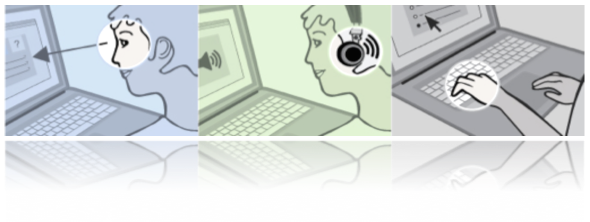
- You will have 15 seconds to read the instructions, the question and the answer choices.
- After the tone, you will hear a dialogue.
- Answer the question.
Accommodation for students with special needs
Since the objective of the TPLS is to determine reading and listening proficiency, no writing support measure (screen reader) or oral support measure (audio transcription) has been provided for in the test. The allotted answer time for each item is regulated by the administrator.
The test is an objective measure of second language proficiency throughout the college network. We therefore request that educational institutions do not adapt it, as we wish to avoid distortion of the data collected.
The CCDMD production team would be pleased to discuss the development of an untimed replacement test, hosted on a separate virtual environment, to meet the needs of colleges wishing to accommodate groups of students with special needs.
The CCDMD can be reached at 514 873-2200 or info@ccdmd.qc.ca.
Administering the Test
The TPLS is intended to be administered twice during a student’s college studies: once at the beginning and once before the diploma is awarded. The test manager of a subscribing college may, however, decide to use it differently. The test can be used as a placement test under certain conditions, as a test within a language course to determine group level or as a measure of the student's level compared to an expected level for certain professional careers. However, since students do not progress rapidly to a higher level of proficiency, it is not recommended they take the test repeatedly during their studies.
The management module provides an institution's test manager with all of the necessary features to manage a subscription. From this module, the manager can create groups, register respondents and define the testing schedule. The manager has access to both the overall results and detailed data. The manager can also configure the test as needed - for example, by associating linguistic scale levels with specific course numbers, reformulating certain messages, choosing whether or not to display results at the end of the test and defining the export format for results to a spreadsheet, for statistical analysis or to the institution's educational platform.
The test can be taken online from home, in class or in a lab. Students can access the test using an ID and a password sent by the test manager. The monitoring of tests administered in class or in a lab is facilitated by the fact that the test progression (the type and order of items) varies with the respondent. Similarly, the correct answer is not always in the same order in the list of answer choices.
Scale of Proficiency Levels
The scale used for the TPLS was developed on the basis of a comparison with three recognized scales in Québec: the Échelle québécoise des niveaux de compétence en français des personnes immigrantes adultes, and the two scales produced at the request of the Ministère de l’Éducation, du Loisir et du Sport: the Quebec College ESL Benchmarks (provisional version), and the Échelle des niveaux de compétence en français langue seconde pour le collégial (provisional version).
These reference scales include 12 levels. For the proficiency test project, only the first 10 levels were taken into account, in order to comply with the reality of most CEGEP students. Also, only skills related to comprehension (oral and written) were included. The results of the comprehension test serve to guide decisions regarding the placement of candidates in the various courses offered. In the development of the linguistic scale, the design team first selected indicators whose content was common to that of at least two scales and that demonstrated potential for operationalization in an adaptive test. The team subsequently chose other indicators that were consistent with and complementary to the ones initially selected. It later added descriptions to the scale from the Canadian Language Benchmarks (CLB).
Importance of a Scale of Proficiency Levels
The interpretation of a proficiency level result based on a scale offers a number of advantages:
- The information obtained is standardized and can thus be compared with that derived from other tests and scales developed according to the same principles;
- The proficiency levels in the scale provide clear, practical information that can be used to analyze programs and develop their content with a view to standardizing second language services at the college level;
- These proficiency levels offer clear, practical information that can be used to formulate the learning objectives to be achieved: students can take the test at the beginning and end of their studies to measure their progression;
- Proficiency test results can be used by students in certain programs to evaluate their proficiency in preparation for language exams administered by the Office québécois de la langue française.
Proficiency Level Descriptions
The Scale of Second Language Proficiency Levels for the College Student describes the development of second language proficiency in 10 levels. For each level, it defines what the learner is able to understand orally and in writing.
The proficiency test is made up of a number of items divided into two categories:
- Items that focus on audio recordings and measure the respondent’s degree of proficiency in oral comprehension;
- Items that focus on texts and measure the respondent’s degree of proficiency in written comprehension.
Oral Comprehension
The items measuring oral comprehension are based on audio recordings, which vary in length and complexity depending on the target proficiency level. The audio recordings serve as the foundation for the questions appearing in one or more items.
Each item in oral comprehension includes:
- General instructions, given in words and images, which specify what the respondent must do, i.e., read the question and the choice of answers BEFORE listening to the recording;
- The audio recording, which starts automatically after a 15-second pause and plays only once. The volume can be adjusted with the slider bar on the screen. The recording can vary in form (audio message, dialogue, discussion, etc.) and provides the basis for the item question; some recordings are accompanied by an image illustrating the context.
- The question;
- The choice of answers;
- The Continue button to go to the next item.
LEVELS 1-2 OC
Level 1
Conditions: In predictable situations, students understand a few isolated words and expressions with the support of the speaker.
More specifically, they can:
- understand information related to times, dates, telephone numbers, addresses;
- understand information related to the days of the week and months of the year;
- identify the parts of the body.
Level 2
Conditions: In predictable situations, students understand simple sentences and short conversations with the support of the speaker.
More specifically, they can:
- understand information related to colours;
- understand information and requests;
- understand information related to an institution;
- follow directions to find their way around an institution;
- understand information related to height, weight and age.
LEVELS 3-4 OC
Level 3
Conditions: In predictable situations, students understand the gist of a simple conversation or message.
More specifically, they can:
- understand information related to measurements;
- understand information related to a housing or domestic problem;
- understand information related to leisure or recreation;
- understand the main idea in an advertisement.
Level 4
Conditions: In predictable situations, students understand the meaning of a simple conversation or message. The topic is familiar, the speech is clear, and the ideas are presented in a direct manner in everyday language.
More specifically, they can:
- understand the main ideas in a presentation;
- understand information related to who?, what?, when?, where? questions;
- understand a telephone message;
- understand a sequence of events based on time markers;
- grasp the intention of a message;
- situate events by identifying time and frequency indicators.
LEVELS 5-6 OC
Level 5
Conditions: In predictable situations, students understand the progression of ideas. The topic is concrete and familiar, the speech is clear, and the ideas are expressed succinctly in everyday language.
More specifically, they can:
- follow a conversation;
- understand key points in a presentation;
- grasp the main ideas in a television or radio show;
- understand the relationship between speakers;
- understand the main ideas in a conversation;
- understand the intention of communication.
Level 6
Conditions: In predictable situations or partially predictable situations, students understand conversations and discourse on concrete topics.
More specifically, they can:
- understand primary and secondary ideas;
- distinguish fact from opinion;
- anticipate a conclusion or recommendation;
- grasp the relationship between speakers.
LEVELS 7-8 OC
Level 7
Conditions: In predictable situations or partially predictable situations, students understand conversations or discourse on various concrete topics. The language is standard and speech is at a normal rate.
More specifically, they can:
- follow most conversations with ease;
- follow a conversation on work or recreational activities;
- make inferences about the attitudes and emotions of speakers or about the mood of a conversation;
- understand a variety of common words and popular idiomatic expressions.
Level 8
Conditions: In predictable situations or partially predictable situations, students understand conversations and opinion discourse on various concrete topics.
More specifically, they can:
- follow most conversations in formal and informal contexts;
- understand a structured presentation given the presence of questions and answers; markers (first, etc.); and words related to a presentation or opinion (present, think, believe, etc.);
- distinguish fact from opinion;
- grasp, comparisons, contrasts, and cause and effect relationships.
LEVELS 9-10 OC
Level 9
Conditions: In sometimes unpredictable situations, students understand conversations and discourse on various, sometimes abstract topics.
More specifically, they can:
- understand points (for and against) that will facilitate decision-making;
- distinguish fact from opinion in a discussion or presentation, even when implicit;
- recognize the tone of a conversation or a presentation;
- understand abstract remarks.
Level 10
Conditions: In sometimes unpredictable situations, students easily understand conversations and discourse on various sometimes abstract topics.
More specifically, they can:
- understand criticism or reservations expressed during formal exchanges;
- follow discourse even when speech is at a fast rate;
- infer contradictions;
- deduce the values conveyed by discourse.
Written Comprehension
The items measuring written comprehension are based on written texts, which vary in length and complexity depending on the target proficiency level. The texts serve as the foundation for the questions appearing in one or more items.
Each item in written comprehension includes:
- General instructions, given in words and images, which specify what the respondent must do, i.e., read the question and choice of answers BEFORE reading the text;
- The text, varying in type (invoice, birthday card, film poster, etc.), which provides the basis for the item question;
- The question;
- The choice of answers;
- The Continue button to go to the next item.
LEVELS 1-2 WC
Level 1
Conditions: Documents are very simple, relate to personal identity and refer to immediate needs. Students understand words, expressions or sentences.
More specifically, they can:
- recognize everyday words and known names of people and places;
- recognize common abbreviations;
- identify the months of the year;
- find elements related to personal identification to enter in a form.
Level 2
Conditions: Documents are very simple, relate to personal identity and refer to immediate needs. Students partially understand brief, simple texts.
More specifically, they can:
- find information in various documents;
- recognize numbers written out in full;
- recognize information used in weather forecasts.
LEVELS 3-4 WC
Level 3
Conditions: Documents are very simple or related to advertising and refer to daily life. Students understand the gist of brief, simple texts.
More specifically, they can:
- understand informative documents;
- understand brief descriptions;
- understand information with the help of key words or visual cues;
- identify basic grammar forms.
Level 4
Conditions: Documents relate to concrete topics and refer to daily life. The language is simple and common. Students understand a few paragraphs.
More specifically, they can:
- situate facts, academic events, classroom activities and instructions in time;
- grasp the sequence of steps in directions;
- answer general comprehension questions (who?, what?, when?, where?);
- compare facts in order to make a choice.
LEVELS 5-6 WC
Level 5
Conditions: Documents relate to concrete topics and may include some complex elements, such as certain uncommon words. Students partially understand a few paragraphs.
More specifically, they can:
- identify information in a news article;
- identify information in an informative text;
- demonstrate their understanding by associating information in a text;
- find relevant information in a notice.
Level 6
Conditions: Documents relate to familiar topics and may include some complex elements, such as uncommon words. Students understand the main information in a one-page text.
More specifically, they can:
- identify all the pertinent information in a news article;
- infer the link between paragraphs;
- identify certain cohesion markers in a text;
- demonstrate their comprehension of a text made up of complex sentences that contain common relationship markers.
LEVELS 7-8 WC
Level 7
Conditions: Documents relate to subjects of general interest and may include complex elements, such as uncommon words or certain implicit concepts. Students understand the main idea in a text.
More specifically, they can:
- identify the main idea and secondary ideas;
- differentiate fact from opinion.
Level 8
Conditions: Documents relate to subjects of general interest and include arguments. Texts may relate to a specific field of study. They include complex elements, such as uncommon words, implicit concepts and abstract ideas. Students understand the main idea in documents of several pages.
More specifically, they can:
- identify the main idea;
- recognize different points of view;
- understand an article related to their field of study;
- understand a literary text.
LEVELS 9-10 WC
Level 9
Conditions: Documents include various complex elements, and may address unfamiliar or abstract topics. Students understand the main idea in complex documents.
More specifically, they can:
- recount the author’s arguments;
- recognize the function of linking words in a text;
- identify the main idea and pinpoint some details.
Level 10
Conditions: Documents include various complex elements, and address abstract topics. Students understand the main idea, the tone and explanations in complex documents.
More specifically, they can:
- recognize adjectives, adverbs and other words that convey tone;
- recognize subtext;
- recognize the links of cause, intention, time and consequence, expressed by the most common subordinating words.
Production Team
Application Design
Research, Educational Design and Drafting
Project Management
Test Evaluation
Translation
Drafting of Online Help Guide
Language Editing
|
System Design and Programming
Web Integration
Graphic Design
Audio Production
Voice
|
AcknowledgmentsDeborah Armstrong, Rebecca Baker, Chantal Bélanger, Kathye Bélanger, Philippe Bonneau, Marie-Pierre Bouchard, Yvonne Christiansen, Marie-Claude Doucet, Cathie Dugas, Paul Fournier, Philippe Gagné, Sylvain Gagnon, Francine Gervais, Sue Harrison, Réjean Jobin, André Laferrière, Charles Lapointe, James Laviolette, Julia Lovatt, Michel D. Laurier, Susan MacNeil, Anne McMullon, Jean-Denis Moffet, Andrew Moore, Joanne Munn, Ian Murchison, Colette Noël, Patrick Peachey, Christian Ragusich, Michael Randall, Pierre Richard, Joan Thompson, Rachel Tunnicliffe, Inèse Wilde
This test was designed for the college network in response to current needs, with the objective of promoting academic success for young students in Québec. Many teachers, professionals and students collaborated in the development of the test and its validation. We would like to thank them all for their valued contributions. This project is funded by the Québec Ministère de l'Éducation et de l'Enseignement supérieur (MEES) and the Canada-Québec Agreement on Minority-language Education and Second Language Instruction. |